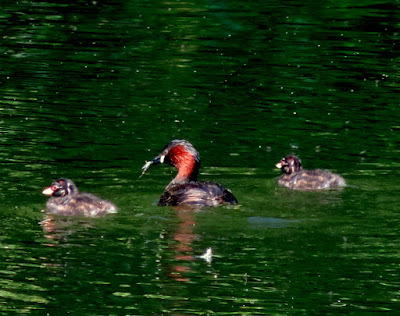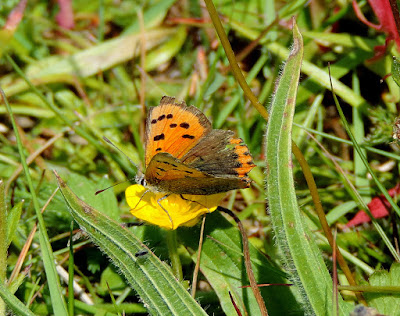Well, after a rather changeable start to the month, the second half of June and the first few days of July have been largely dry, sunny and warm - very warm at times, the temperature peaking at 35 degrees celsius on 1st July. The arboretum is a wonderful place to be in such conditions with welcome relief to be found from the baking heat under the shade of the trees.
Talking of fledglings, there are now juvenile birds all over the place. Just the last few days I have seen young Great Spotted Woodpeckers, Blackbirds, Song Thrushes, Mistle Thrushes, Robins, Great Tits and Blue Tits around the arboretum, while the occasional flocks of Swallows over Rowe's Flashe Lake now often include juveniles. The Treecreeper nestlings in the wall of the boathouse have now fledged and I saw the adults feeding them in the nearby group of Scot’s Pines on 20th June. On the other side of the lake, meanwhile, I noted a family group of Chiffchaffs in the Alders.
Juvenile Treecreeper
Most of the ducks on the lake now are in eclipse plumage, meaning they are moulting. This can make identification rather tricky to the casual observer, as normally unmistakeable species become drab and difficult to identify or sex, like this drake Mandarin.
which normally looks like this...
Little Grebe with young
On the morning of 3rd July there was a Reed Warbler singing in the small patch of reeds on the east side of the lake. A rather unusual record for the time of year and my 88th bird species at Winkworth in 2015.
After several weeks' absence, I have again been seeing a Kingfisher at Rowe's Flashe Lake, with one present on 24th and 30th June. Also of note, I saw a pair of adult Grey Wagtails carrying food near the boathouse on 3rd July.
Another species that's been rather quiet lately is Marsh Tit, so it's good to have started seeing and hearing them again along the Phillimore Wetland path this past week or so - this particularly bold one was flitting about in the bushes on the edge of Furze Field on 1st July.
Buzzards and Red Kites remain an almost daily sight, while Kestrels are rather less frequent - there was a male circling over Rowe's Flashe Lake on 3rd July. Sparrowhawks have been very scarce just lately though, and clearly the nest I saw a male adding material to earlier in the year has not been occupied. Ravens have been a more common flyover in recent weeks, with two seen soaring over the boathouse on 29th June and one over the Badger's Bowl on 1st July.
As I mentioned in my previous blog post, mid-June can be a rather quiet time for butterflies but the last week or so has seen the emergence of many of the high summer species, In the meadow areas there are now Marbled Whites, Ringlets and Large and Small Skippers, while under the trees or up the Azalea Steps you will find White Admirals and Silver-washed Fritillaries. Indeed, on 3rd July a very inquisitive Silver-washed followed me around as I was watering newly-planted trees in the upper arboretum, even flying through the cab of our off-road buggy several times as I tried to drive off! Here are a few butterflies I've photographed in the arboretum recently:
Small Heath (Coenonympha pamphilus)
Small Copper (Lycaena phlaeas)
Large Skipper (Ochlodes venata)
Ringlet (Aphantopus hyperantus)
Common Blue - female (Polyommatus icarus)
The other sure sign, of course, of the onset of high summer, is the prevalence of dragonflies and damselflies, and there have been plenty to see around the arboretum in the recent hot weather. I'm still getting to grips with the Odonata order, but I do know the first one pictured below is a male Common Blue Damselfly and I'm fairly confident the second is a female Black-tailed Skimmer.
With the summer weather now well and truly upon us I'm looking forward to seeing what else the sunshine brings in the coming weeks and sharing them with you!













